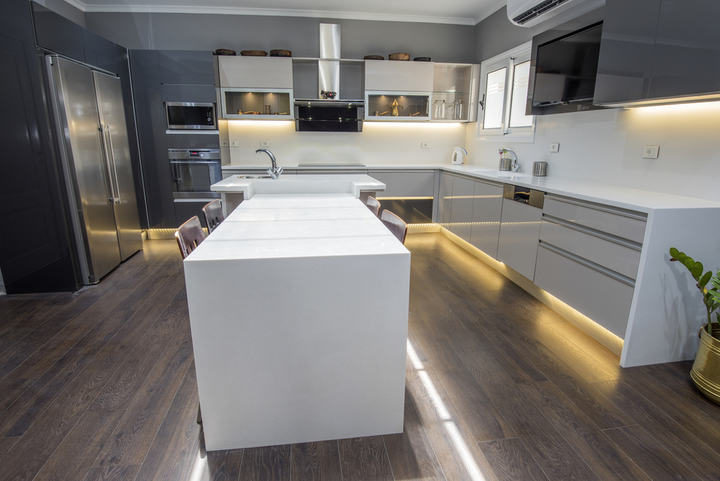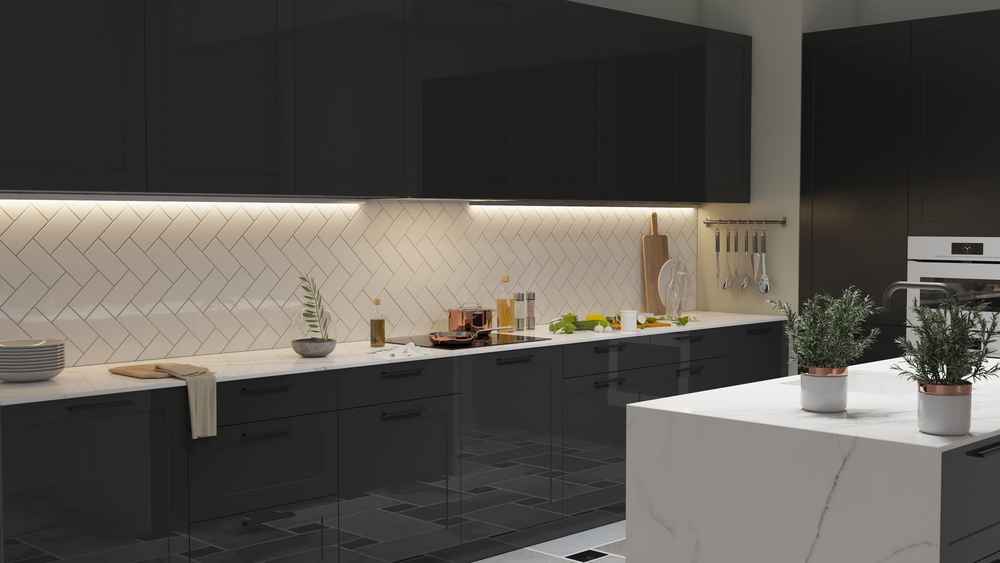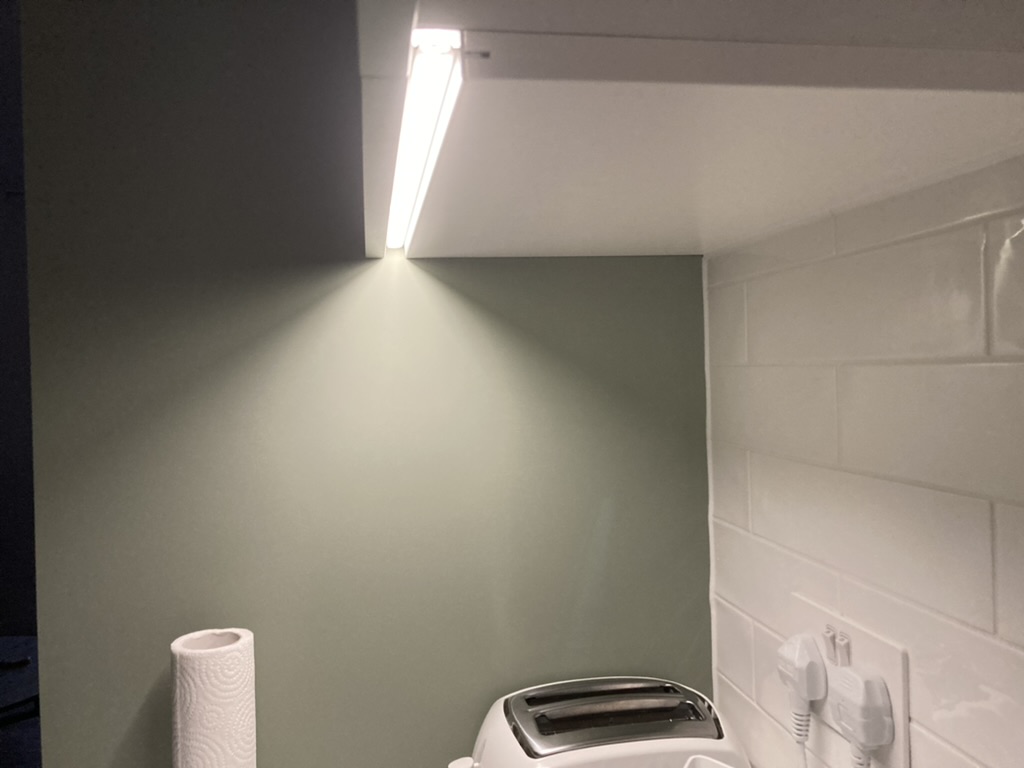Under-cabinet lighting is a great way to either add a more pleasant ambiance to the room or make it easier to see what you’re doing when preparing dinner.
LED strip lights are great for kitchens because they’re bright, discreet, and long-lasting.
And it’s that last point that I want to address in this post because it’s a good thing that LEDs have a long lifespan – installing them can be tricky, and you don’t want to have to replace them frequently.
It’s not super-hard, but there are a few things you need to bear in mind if you want a really nice lighting setup that doesn’t look messy and spoil your kitchen design.
Under-cabinet LED strip lights can be installed at the rear of cabinets for ambient lighting or nearer the front for task lighting. Wires can be hidden using cable protectors or by running them into the cabinet – but the key is having a power outlet within easy reach.
To help you install your perfect LED strip lighting setup in your kitchen, let’s take a look at:
- Where you can mount your LED strip lights
- How to hide lights
- How to wire the lighting
Where To Mount LED Strip Lights Under Cabinet?
Depending on where you’re mounting your LED strip lights, there are a few potential considerations that you need to be aware of.
But if you’re installing LED strip lights on the underside of cabinets at floor level, that’s pretty straightforward.
You just need to ensure your cabinets have an exposed underside between the bottom of the cabinet and the floor.
If the floor panel is recessed a little, as it is in most kitchens, then you can easily install the strip lights on the underside of the cabinet that hangs out over the floor.
Because that won’t be a large overhang, you don’t need to worry too much about the positioning of the lights.
There isn’t much difference between whether you place them towards the front or rear of the space because it’s already relatively thin.
You need to think a little more about wall-mounted cabinets at eye level.
Installing LED strips on the underside of these cabinets is an excellent way of adding light to your kitchen worktops.
However, depending on your design for the lights, you will have to think about where you want to place the strips.
You have two main options.
If you see the LED lights as purely decorative, install them towards the rear of the cabinet, close to the wall.
The light produced will blend into the wall more, brightening the space with a more even glow.
However, if you want to use your lighting to ensure you’ve got a safer space to work in the kitchen (when you’re prepping food using sharp tools), then that’s called task lighting.
For this purpose, you’ll want to install your LED lights closer to the front of the cabinet.
Not right at the front because you’ll lose some of the light over the edge of the worktop.
Instead, a mid-front location will provide the best level of light in the workspace that you’ll be using.
One other factor for installing LED strip lights under wall-mounted cabinets is waterproofing.
If you plan on having LED strip lights near your stovetop, you must ensure they’re safe when they come into contact with steam.
Some manufacturers will advertise that their LED strip lights are rated IP20 and therefore safe for steam, but that’s not true and dangerous.
An IP20 rating means they aren’t waterproof at all.
Look for strip lights with a waterproof rating of at least IP65 if they’re close to any steam coming from the stove.
This is also a factor in how you install the lights. Strip lights for kitchens can either come as a standard bare strip light or within a plastic casing.
Those in a plastic casing will need to be properly screw-mounted anyway, but standard bare strip lights will often rely on their own adhesive backing.
While that does make installation much easier, you need to make sure that the adhesive isn’t going to be weakened by steam from the stove.
You may need to use additional mounting staples to keep the LED strip in place if it’s close to any sources of steam in the kitchen.
How Do I Hide Under Cabinet Lights?
The great thing about using LED strip lights for your under-cabinet lights is their low profile.
The lights themselves are super-thin, so once installed, you’ll only see them if you duck down to look underneath the cabinet.
Otherwise, you would never know they were there, except they’re beaming light onto the worktop.
However, the wires are another issue.
These can potentially hang down if installed with any flex, so you may need to take steps to hide them.
Here are some options:
Valance
There’s a good chance that your cabinets already have a valance, but if they don’t, consider adding one.
A valance is a strip of wood that acts as an extension to your wall-mounted cabinets, essentially providing a lip.
Its primary function is decorative – it stops your wall cabinets from having a harsh squared-off edge – but because it creates a lip it can also hide anything on the underside of the cabinets.
Cable Protector

For most people adding a cable, the protector is the easiest way to hide wires.
They’re cheap and can be painted to match the cabinet color so that they’re still discreet if they are seen.
Simply bundle the wires together carefully and feed them through the protector.
You don’t have to use a protector – you could just bundle the wires together, cable-tie them and then staple them to the underside of the cabinet.
It’s a little messier, but it’s not a huge problem if it keeps the wires pinned where they aren’t visible.
Just make sure you don’t accidentally damage the wires.
Run Into The Cabinet
Depending on your kitchen layout, one possible option would be to modify your cabinets by drilling through them and running the wiring up into the cabinet’s interior.
You’d still need to then hide it, unless you didn’t mind seeing the loose wire when you open the cabinet door, but you might find it easier if it’s already partially hidden away.
How To Wire Under Cabinet LED Lighting?
Wiring LED lighting under cabinets is pretty straightforward.
Your strip lights will likely come with their own power source and method of connecting them.
If not, then you can buy separate power supplies that have connectors designed for either strip light wires or strip light contact points.
Just make sure you buy the right power supply (Amazon) for your strip – likely 12V or 24V. It must match, or you risk either underpowering the lights or damaging them.
However, your biggest concern will likely be finding the best plug outlet for your strip lights since you don’t want to spend a long time making sure the lights are hidden away only to have a plug wire hanging down messily.
Again, you can use a cable protector to pin the wires to the wall, but make sure you’ve planned for each section of strip lighting.
If you have a stove hood in the middle of your kitchen, you will need separate plug outlets for the strip lights on either side.
Alternatively, you’ll have to run the wire up the side of the cabinet near the hood and then over the top of it.
The best solution is to have an outlet hidden inside your cabinets – that way, you don’t have to worry about hiding wires on the wall.
If you’re planning a new kitchen design, consider installing an outlet behind the cabinets to make powering your strip lights easier.
Final Words
Neatly installing LED strip lights just takes a little bit of careful planning in advance. Thankfully, strip lights have a lifespan, so you shouldn’t need to change them every couple of years.
Your biggest considerations are making sure that you can hide the wires and that you’ve got easy access to an outlet.
Also, remember the stove and whether you need to factor steam into your installation – that’ll impact which strip lights you choose and how you fit them.
Have you got LED strip lights in your kitchen, and did you install them yourself?
If you did, I’d love for you to share your own tips with readers to make it even easier for them to add their own strip lights to their homes.
Plus, check out my in-depth guide to LED strip lights for everything you need to know about installing them in your home.




